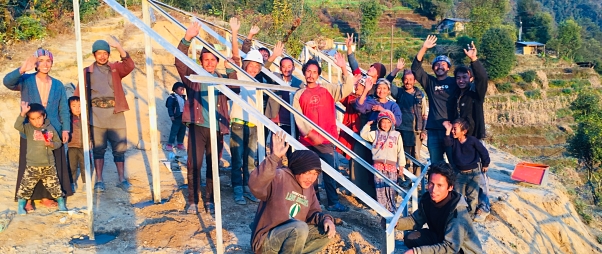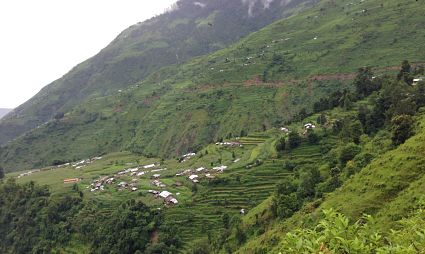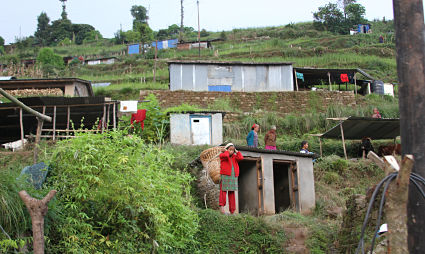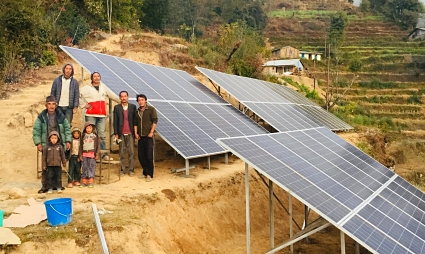
Chatang is located in the Nuwakot District of central Nepal, and despite neighboring the capital district of Kathmandu, the region is not as developed and lacks essential infrastructure, like access to the electric grid. The remote community is at least 3 hours walking from the nearest road and current sources of energy for lighting and cooking include flashlights and kerosene oil lamps, which are expensive and unreliable. A micro-grid is a better option to power the community, and will provide energy for basic needs and essential infrastructure, such as lighting, communication, healthcare, and local revenue generation.
 There are 60 existing households in Chatang, and there are future plans to build 20 additional homes for a total of 80. The residents of Chatang are part of the Tamang ethnic group and Lama clan, indigenous to the Himalayan regions of Nepal and India. Most families are subsistence farmers who grow crops on the terraced hillsides. Three of these households are already running small shops out oftheir homes, and other families have expressed interest in starting small businesses out of their homes once they have access to reliable electricity through solar. Women in the community tend to do the daily water collection and gather wood for fuel, and men undertake much of the agricultural work.
There are 60 existing households in Chatang, and there are future plans to build 20 additional homes for a total of 80. The residents of Chatang are part of the Tamang ethnic group and Lama clan, indigenous to the Himalayan regions of Nepal and India. Most families are subsistence farmers who grow crops on the terraced hillsides. Three of these households are already running small shops out oftheir homes, and other families have expressed interest in starting small businesses out of their homes once they have access to reliable electricity through solar. Women in the community tend to do the daily water collection and gather wood for fuel, and men undertake much of the agricultural work.
 In Chatang, there is no access to the national electric grid, but some homes have very small stand-alone 20W or 100W solar home systems that were distributed as part of a government program at a subsidized rate of 50%. While the small solar home systems have been useful, the government agency is not there to assist with ongoing system maintenance, and the cost of replacement parts like batteries is not subsidized. Other sources of energy include flashlights and kerosene oil lamps, which are expensive, unreliable, and toxic non-renewable energy sources for lighting and cooking. Like in Chatang, solar has a presence in some of Nepal’s rural regions, where you might see small systems like these dangling from rooftops that likewise are part of the government program. There is no incentive for the original installers to maintain such small systems in hard to reach rural villages. A micro-grid is a better option to power the community, providing energy for basic needs and very essential infrastructure, such as lighting, communication, healthcare, and local revenue generation.
In Chatang, there is no access to the national electric grid, but some homes have very small stand-alone 20W or 100W solar home systems that were distributed as part of a government program at a subsidized rate of 50%. While the small solar home systems have been useful, the government agency is not there to assist with ongoing system maintenance, and the cost of replacement parts like batteries is not subsidized. Other sources of energy include flashlights and kerosene oil lamps, which are expensive, unreliable, and toxic non-renewable energy sources for lighting and cooking. Like in Chatang, solar has a presence in some of Nepal’s rural regions, where you might see small systems like these dangling from rooftops that likewise are part of the government program. There is no incentive for the original installers to maintain such small systems in hard to reach rural villages. A micro-grid is a better option to power the community, providing energy for basic needs and very essential infrastructure, such as lighting, communication, healthcare, and local revenue generation.
 Community-based solar micro-grids have great potential to contribute to development around the world. Yet today, few rural micro-grid models exist that are self-sustaining and meet the long-term needs of beneficiaries. In addition to clean, reliable lighting, a community micro-grid in Chatang has potential to create employment opportunities for local residents and catalyze the area as a small market center for travelers along the popular Goshaikunda trekking route. "Anchor loads," local enterprises that use power to provide a product or service to the community, have proven key to project success and sustainability. The solar micro-grid is designed with these objectives in mind, and will be installed in partnership with local solar company Gham Power.
Community-based solar micro-grids have great potential to contribute to development around the world. Yet today, few rural micro-grid models exist that are self-sustaining and meet the long-term needs of beneficiaries. In addition to clean, reliable lighting, a community micro-grid in Chatang has potential to create employment opportunities for local residents and catalyze the area as a small market center for travelers along the popular Goshaikunda trekking route. "Anchor loads," local enterprises that use power to provide a product or service to the community, have proven key to project success and sustainability. The solar micro-grid is designed with these objectives in mind, and will be installed in partnership with local solar company Gham Power.
 Residents and businesses will pre-pay for electricity from the solar micro-grid through a smart meter, which allows them to track their electricity usage and avoid using more electricity than they can afford. During daylight hours, the system produces more energy than the community consumes, and the surplus energy can be stored in the battery bank, enabling electricity usage at night. Electricity through a solar micro-grid will provide a safer, more affordable lighting option for homes; enable students to accelerate their learning; allow residents to charge cell phones and other devices cheaply and locally; and provide local businesses and entrepreneurs with the energy they need to be successful.
Residents and businesses will pre-pay for electricity from the solar micro-grid through a smart meter, which allows them to track their electricity usage and avoid using more electricity than they can afford. During daylight hours, the system produces more energy than the community consumes, and the surplus energy can be stored in the battery bank, enabling electricity usage at night. Electricity through a solar micro-grid will provide a safer, more affordable lighting option for homes; enable students to accelerate their learning; allow residents to charge cell phones and other devices cheaply and locally; and provide local businesses and entrepreneurs with the energy they need to be successful.
This project was sponsored by Northland Controls, and their support made it possible for GRID Alternatives to bring a micro-grid to the Chatang community. Corporate sponsorships are critical in enabling GRID to bring the benefits of solar- financial savings, job opportunities, and a clean, renewable energy source- to families and communities that would not otherwise have access. Learn more about becoming a corporate sponsor for our international projects.
See photos of the completed installation here!



